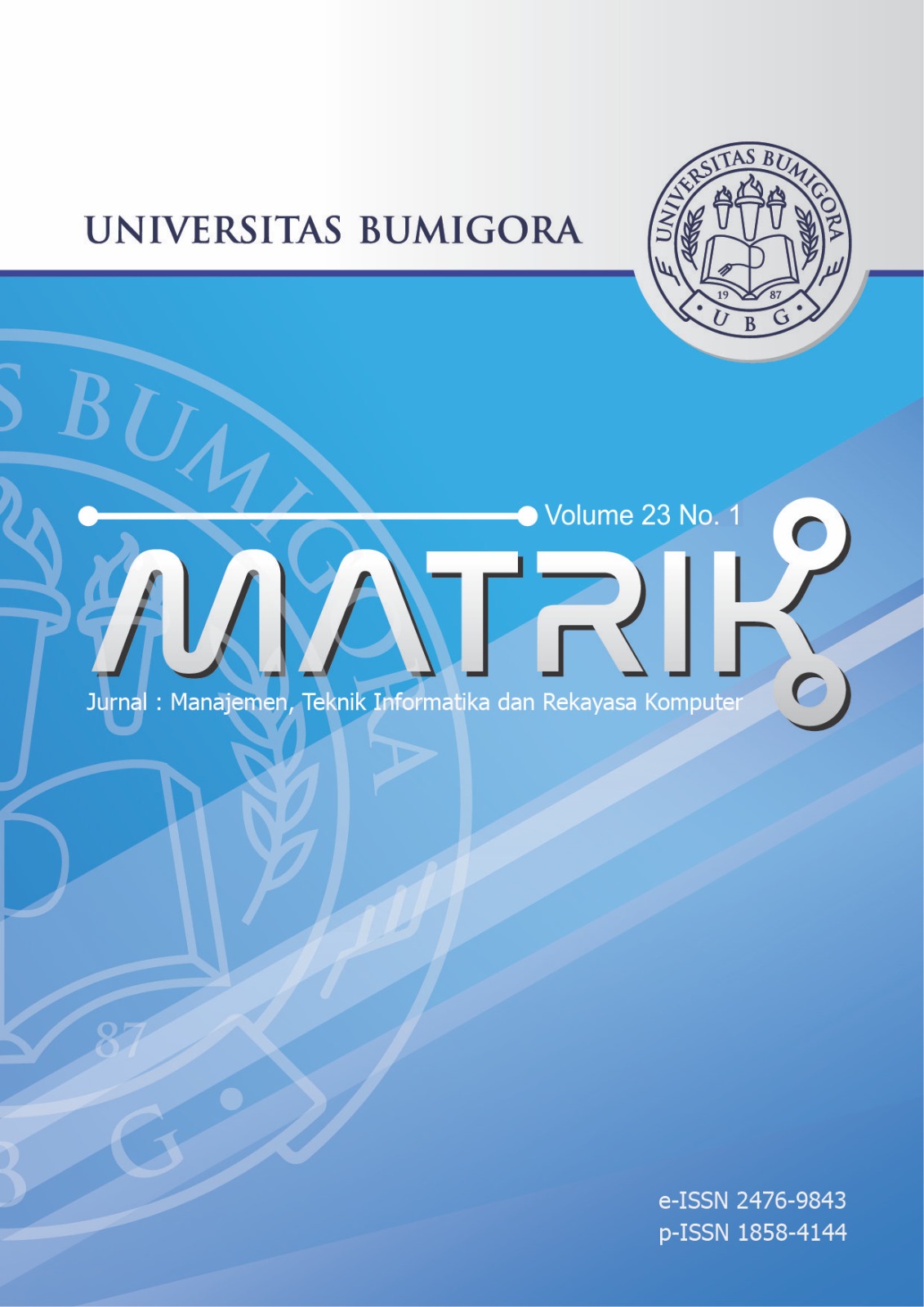Lungs X-Ray Image Segmentation and Classification of Lung Disease using Convolutional Neural Network Architectures
DOI:
https://doi.org/10.30812/matrik.v23i1.3133Keywords:
Classification, Convolutional Neural Network, Lung Disease, SegmentationAbstract
Lung disease is one of the biggest causes of death in the world. The SARS-CoV-2 virus causes diseases like COVID-19, and the bacteria Streptococcus sp., which causes pneumonia, are two sample causes of lung disease. X-ray images are used to detect the lung disease. This study aimed to combine the stages of segmentation and classification of lung disease. This study in segmentation aims to separate the features contained in the lung images. The classification aimed to provide holistic information on lung disease. This research method used the Deep Residual U-Net (DrU-Net) segmentation architecture and the Deep Residual Neural Network (DResNet) classification architecture. DrU-Net is a modified U-Net architecture with dropout added in its convolutional layers. DResNet is a modified Residual Network (ResNet) architecture with dropout added in its convolutional block layers. The result of this study was segmentation using the DrU-Net architecture obtained 99% for accuracy, 98% for precision, 98% for recalls, 98% for F1-Score, and 96.1% for IoU. The classification results of the segmented images using the DResNet architecture obtained 91% for accuracy, 86% for precision, 85% for recalls, and 84% for F1-Score. The performance results of DrU-Net architecture were excellent and robust in image segmentation. Unfortunately, the average performance of DResNet in classification was still below 90%. These results indicate that Dres-Net performs well in classifying lung disorders in 3 labels, namely Covid, Normal, and Pneumonia, but still needs improvement.
Downloads
References
cancer in the future,†Infectious Agents and Cancer, vol. 17, no. 20, pp. 1–12, dec 2022.
[2] T. Pranata, A. Desiani, B. Suprihatin, H. Hanum, and F. Efriliyanti, “Segmentation of the Lungs on X-Ray Thorax Images with
the U-Net CNN Architecture,†Computer Engineering and Applications Journal, vol. 11, no. 2, pp. 101–111, 2022.
[3] A. M. Baig, A. Khaleeq, U. Ali, and H. Syeda, “Evidence of the COVID-19 Virus Targeting the CNS: Tissue Distribution,
HostVirus Interaction, and Proposed Neurotropic Mechanisms,†ACS Chemical Neuroscience, vol. 11, no. 7, pp. 995–998, apr
2020.
[4] M. Abu-Farha, T. A. Thanaraj, M. G. Qaddoumi, A. Hashem, J. Abubaker, and F. Al-Mulla, “The Role of Lipid Metabolism in
COVID-19 Virus Infection and as a Drug Target,†International Journal of Molecular Sciences, vol. 21, no. 10, pp. 1–11, may
2020.
[5] P. Pagliano, C. Sellitto, V. Conti, T. Ascione, and S. Esposito, “Characteristics of viral pneumonia in the COVID-19 era: an
update,†Infection, vol. 49, no. 4, pp. 607–616, 2021.
[6] M. Nour, Z. C¨omert, and K. Polat, “A Novel Medical Diagnosis model for COVID-19 infection detection based on Deep
Features and Bayesian Optimization,†Applied Soft Computing, vol. 97, no. December, pp. 1–13, dec 2020.
[7] M. Yahyatabar, P. Jouvet, and F. Cheriet, “Dense-Unet: a light model for lung fields segmentation in Chest X-Ray images,â€
in 2020 42nd Annual International Conference of the IEEE Engineering in Medicine & Biology Society (EMBC), 2020, pp.
1242–1245.
[8] H. Shaziya and K. Shyamala, “Pulmonary CT Images Segmentation using CNN and UNet Models of Deep Learning,†in 2020
IEEE Pune Section International Conference, PuneCon 2020, 2020, pp. 195–201.
[9] X. Zhang, J. Zhou, W. Sun, and S. K. Jha, “A Lightweight CNN Based on Transfer Learning for COVID-19 Diagnosis,â€
Computers, Materials and Continua, vol. 72, no. 1, pp. 1123–1137, 2022.
[10] M. F. Aslan, K. Sabanci, A. Durdu, and M. F. Unlersen, “COVID-19 diagnosis using state-of-the-art CNN architecture features
and Bayesian Optimization,†Computers in Biology and Medicine, vol. 142, no. March, pp. 1–11, mar 2022.
[11] A. Das, “Adaptive UNet-based Lung Segmentation and Ensemble Learning with CNN-based Deep Features for Automated
COVID-19 Diagnosis,†Multimedia Tools and Applications, vol. 81, no. 4, pp. 5407–5441, 2022.
[12] M. F. Aslan, “A robust semantic lung segmentation study for CNN-based COVID-19 diagnosis,†Chemometrics and Intelligent
Laboratory Systems, vol. 231, no. 15, pp. 1–12, dec 2022.
[13] S. Niranjan Kumar, P. M. Bruntha, S. Isaac Daniel, J. A. Kirubakar, R. Elaine Kiruba, S. Sam, and S. Immanuel Alex Pandian,
“Lung Nodule Segmentation Using UNet,†in 2021 7th International Conference on Advanced Computing and Communication
Systems (ICACCS), vol. 1, 2021, pp. 420–424.
[14] S. A. Khan, M. Nazir, M. A. Khan, T. Saba, K. Javed, A. Rehman, T. Akram, and M. Awais, “Lungs nodule detection framework
from computed tomography images using support vector machine,†Microscopy Research and Technique, vol. 82, no. 8, pp.
1256–1266, aug 2019.
[15] D. Sarwinda, R. H. Paradisa, A. Bustamam, and P. Anggia, “Deep Learning in Image Classification using Residual Network
(ResNet) Variants for Detection of Colorectal Cancer,†Procedia Computer Science, vol. 179, pp. 423–431, 2021.
[16] B. Li and D. Lima, “Facial expression recognition via ResNet-50,†International Journal of Cognitive Computing in Engineering,
vol. 2, no. June, pp. 57–64, jun 2021.
[17] S. Bharati, P. Podder, M. R. H. Mondal, and V. S. Prasath, “CO-ResNet: Optimized ResNet model for COVID-19 diagnosis
from X-ray images,†International Journal of Hybrid Intelligent Systems, vol. 17, no. 1-2, pp. 71–85, jul 2021.
[18] T. A. Youssef, B. Aissam, D. Khalid, B. Imane, and J. E. Miloud, “Classification of chest pneumonia from x-ray images using
new architecture based on ResNet,†in 2020 IEEE 2nd International Conference on Electronics, Control, Optimization and
Computer Science (ICECOCS), 2020, pp. 1–5.
[19] Y. Ma, X. Xu, and Y. Li, “LungRN+NL: An Improved Adventitious Lung Sound Classification Using Non-Local Block ResNet
Neural Network with Mixup Data Augmentation,†in Interspeech 2020. ISCA: ISCA, oct 2020, pp. 2902–2906.
[20] A. Desiani, Erwin, B. Suprihatin, F. Efriliyanti, M. Arhami, and E. Setyaningsih, “VG-DropDNet a Robust Architecture for
Blood Vessels Segmentation on Retinal Image,†IEEE Access, vol. 10, no. June, pp. 92 067–92 083, 2022.
[21] J. Li, Y. Zhang, L. Gao, and X. Li, “Arrhythmia Classification Using Biased Dropout and Morphology-Rhythm Feature With
Incremental Broad Learning,†IEEE Access, vol. 9, pp. 66 132–66 140, 2021.
[22] A. A. A. Ali and S. Mallaiah, “Intelligent handwritten recognition using hybrid CNN architectures based-SVM classifier with
dropout,†Journal of King Saud University - Computer and Information Sciences, vol. 34, no. 6, pp. 3294–3300, 2022.
[23] D. Milan´es-Hermosilla, R. Trujillo Codorni´u, R. L´opez-Baracaldo, R. Sagar´o-Zamora, D. Delisle-Rodriguez, J. J. Villarejo-
Mayor, and J. R. Nu´n˜ez-A´ lvarez, “Monte Carlo Dropout for Uncertainty Estimation andMotor Imagery Classification,†Sensors,
vol. 21, no. October, pp. 1–18, oct 2021.
[24] C. Guo, M. Szemenyei, Y. Yi, W. Wang, B. Chen, and C. Fan, “SA-UNet: Spatial Attention U-Net for Retinal Vessel Segmentation,â€
in 2020 25th International Conference on Pattern Recognition (ICPR), 2021, pp. 1236–1242.
[25] Faiz Nashrullah, Suryo Adhi Wibowo, and Gelar Budiman, “The Investigation of Epoch Parameters in ResNet-50 Architecture
for Pornographic Classification,†Journal of Computer, Electronic, and Telecommunication, vol. 1, no. 1, pp. 1–8, 2020.
[26] X. Wang, X. Deng, Q. Fu, Q. Zhou, J. Feng, H. Ma, W. Liu, and C. Zheng, “A Weakly-Supervised Framework for COVID-19
Classification and Lesion Localization from Chest CT,†IEEE Transactions on Medical Imaging, vol. 39, no. 8, pp. 2615–2625,
aug 2020.
[27] N. Paluru, A. Dayal, H. B. Jenssen, T. Sakinis, L. R. Cenkeramaddi, J. Prakash, and P. K. Yalavarthy, “Anam-Net: Anamorphic
Depth Embedding-Based Lightweight CNN for Segmentation of Anomalies in COVID-19 Chest CT Images,†IEEE Transactions
on Neural Networks and Learning Systems, vol. 32, no. 3, pp. 932–946, mar 2021.
[28] G. Pezzano, O. D´ıaz, V. Ribas, and P. Radeva, “CoLe-CNN+: Contect learning - Convolutional neural Network for COVID-
19-Ground-Glass-Opacities detection and segmentation,†Computers in Biology and Medicine, vol. 136, no. 104689, pp. 1–10,
2021.
[29] A. Souid, N. Sakli, and H. Sakli, “Classification and Predictions of Lung Diseases from Chest X-rays Using MobileNet V2,â€
Applied Sciences, vol. 11, no. 6, pp. 1–16, mar 2021.
[30] A. Abbas, M. M. Abdelsamea, and M. M. Gaber, “Classification of COVID-19 in chest X-ray images using DeTraC deep
convolutional neural network,†Applied Intelligence, vol. 51, no. 2, pp. 854–864, feb 2021.
Downloads
Published
Issue
Section
How to Cite
Similar Articles
- Muhammad Ibnu Choldun Rachmatullah, The Application of Repeated SMOTE for Multi Class Classification on Imbalanced Data , MATRIK : Jurnal Manajemen, Teknik Informatika dan Rekayasa Komputer: Vol. 22 No. 1 (2022)
- Aini Suri Talita, Aristiawan Wiguna, Implementasi Algoritma Long Short-Term Memory (LSTM) Untuk Mendeteksi Ujaran Kebencian (Hate Speech) Pada Kasus Pilpres 2019 , MATRIK : Jurnal Manajemen, Teknik Informatika dan Rekayasa Komputer: Vol. 19 No. 1 (2019)
- Heru Pramono Hadi, Eko Hari Rachmawanto, Rabei Raad Ali, Comparison of DenseNet-121 and MobileNet for Coral Reef Classification , MATRIK : Jurnal Manajemen, Teknik Informatika dan Rekayasa Komputer: Vol. 23 No. 2 (2024)
- Dairoh Dairoh, Very Kurnia Bakti, Muhammad Naufal, Neural Network dan Particle Swam Optimization untuk Penunjang Keputusan Antipasi Mahasiswa Pra Lulus Bekerja Sesuai Bidang , MATRIK : Jurnal Manajemen, Teknik Informatika dan Rekayasa Komputer: Vol. 21 No. 1 (2021)
- Nella Rosa Sudianjaya, Chastine Fatichah, Segmentation and Classification of Breast Cancer Histopathological Image Utilizing U-Net and Transfer Learning ResNet50 , MATRIK : Jurnal Manajemen, Teknik Informatika dan Rekayasa Komputer: Vol. 24 No. 1 (2024)
- Syafri Arlis, Muhammad Reza Putra, Musli Yanto, Improved Image Segmentation using Adaptive Threshold Morphology on CT-Scan Images for Brain Tumor Detection , MATRIK : Jurnal Manajemen, Teknik Informatika dan Rekayasa Komputer: Vol. 23 No. 3 (2024)
- Firda Yunita Sari, Maharani sukma Kuntari, Hani Khaulasari, Winda Ari Yati, Comparison of Support Vector Machine Performance with Oversampling and Outlier Handling in Diabetic Disease Detection Classification , MATRIK : Jurnal Manajemen, Teknik Informatika dan Rekayasa Komputer: Vol. 22 No. 3 (2023)
- Prihandoko Prihandoko, Deny Jollyta, Gusrianty Gusrianty, Muhammad Siddik, Johan Johan, Cluster Validity for Optimizing Classification Model: Davies Bouldin Index – Random Forest Algorithm , MATRIK : Jurnal Manajemen, Teknik Informatika dan Rekayasa Komputer: Vol. 24 No. 1 (2024)
- Helna Wardhana, I Made Yadi Dharma, Khairan Marzuki, Ibjan Syarif Hidayatullah, Implementation of Neural Machine Translation in Translating from Indonesian to Sasak Language , MATRIK : Jurnal Manajemen, Teknik Informatika dan Rekayasa Komputer: Vol. 23 No. 2 (2024)
- Bobby Poerwanto, Fajriani Fajriani, Resilient Backpropagation Neural Network on Prediction of Poverty Levels in South Sulawesi , MATRIK : Jurnal Manajemen, Teknik Informatika dan Rekayasa Komputer: Vol. 20 No. 1 (2020)
You may also start an advanced similarity search for this article.
Most read articles by the same author(s)
- Anita Desiani, Irmeilyana Irmeilyana, Endro Setyo Cahyono, Des Alwine Zayanti, Sugandi Yahdin, Muhammad Arhami, Irvan Andrian, Combination Contrast Stretching and Adaptive Thresholding for Retinal Blood Vessel Image , MATRIK : Jurnal Manajemen, Teknik Informatika dan Rekayasa Komputer: Vol. 22 No. 1 (2022)


.png)












